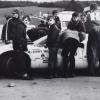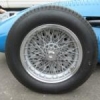I was reading about the development of these cars the other day. Excuse me while I describe the project in broad terms, and if I am unfairly critical, ascribe that to ignorance rather than arrogance.
The 77 was the "let's think about basic principles" car with its adjustable track and wheelbase. The car displayed some aspects of future thinking -- making components serve two purposes, slim monocoque and nose. The original car may have been physically flexible as well adjustable, but Lotus sorted that out quickly. The win at Japan 1976 was a bit of a fluke but the car looked good before that. It was a massive confidence builder and it served a purpose. I don't need to describe the successors, do I?
Behind the scenes at Lotus, Peter Wright had been recruited and was allowed to pursue the "wing on the side of the car" concept which he had conceived at BRM c.1970. Tony Rudd moved from the production car team to GP car design alongside Tony Southgate and Ralph Bellamy, with various overlaps of working together. Nigel Bennett brought his experience working for tyre manufacturers. Other less well known names brought different specialist knowledge (e.g. aluminium honeycomb). Somewhere in this we have to fit Colin Chapman.
When you bring such a talented bunch together, two possible results are 1) Massive Ego Wars or 2) Minor Ego Skirmishes leading to brilliant design. The 78 and 79 are great achievements of project management, and I'd really like to know how Lotus brought out the best of people.
What did other British teams think about the accumulation of talent at Lotus?
Could Lotus afford to employ so many people on F1 development? Was it a throw caution to the wind project to rejuvenate Lotus?
How much nonsense was fed to journalists during early appearances of the Lotus 78? I'm thinking of Mario's tales about differentials and adjustable roll bars and adjustable brake balance and fuel tank control. I'm also thinking about how they made him feel good as a driver even if they made no difference to a bloody fast car. Sorry, Doug Nye, but I reckon that when DCN was writing the first version of Theme Lotus he was being fed some rose fertiliser about the new cars of the day.
What happened to brushes to seal the car underside? Didn't anyone experiment at home with a vacuum cleaner hose and one of those draught excluder flaps which only abrade carpet?
The Transmission Things. A better transmission was one way to beat other teams relying on a Cosworth/Hewland package. At various times, Lotus experimented with clutch design, pedal layout, a redesigned Queerbox, and other stuff no doubt. Perhaps they pushed development of differentials but I am unsure what else they achieved. John Barnard showed, in later years, that a better gearbox could make a difference -- a massively expensive difference.
In 1977, Lotus had the fastest car and they convinced a few other teams to copy it (e.g. Wolf) in the following year. In 1978, Lotus again had the fastest car and almost everyone copied the new version; next season, some teams seemed to understood how it worked better than Lotus. The other teams deserved their success.
For obvious reasons, people who worked on the Lotus 80 project are less willing to talk about what went wrong. They might feel embarrassed about technology failures. Personally, I'm interested in how Lotus misconceived how the 79 ought to have been improved and how Lotus underrated the opposition. And how Lotus responded to the Lotus 80 failure.





















